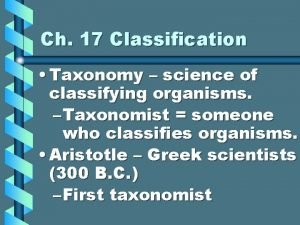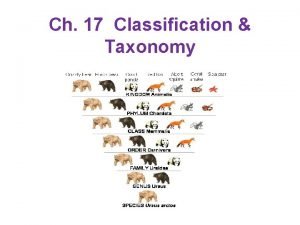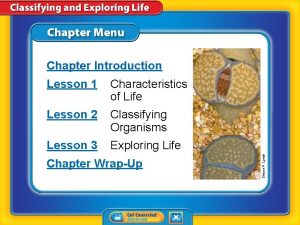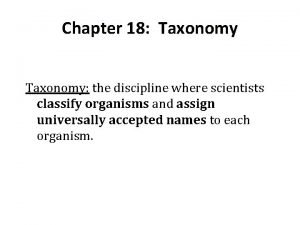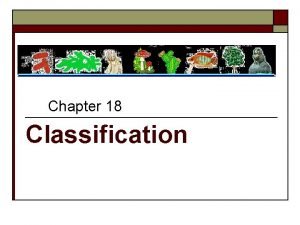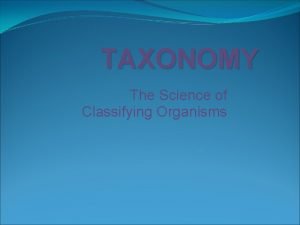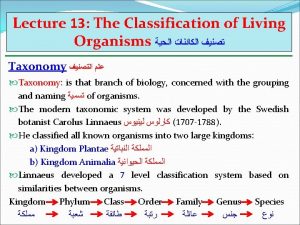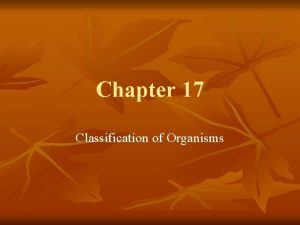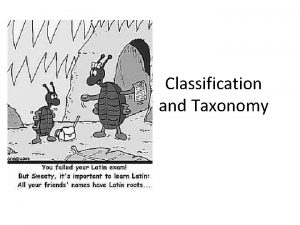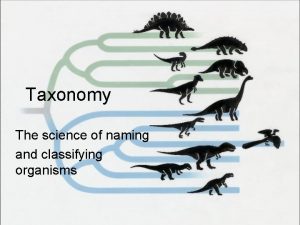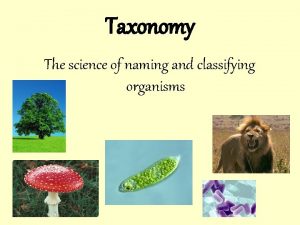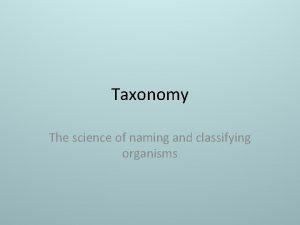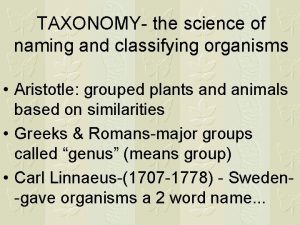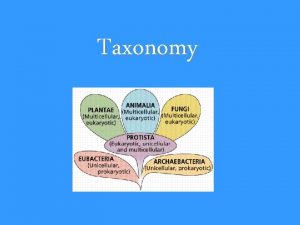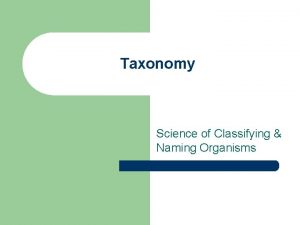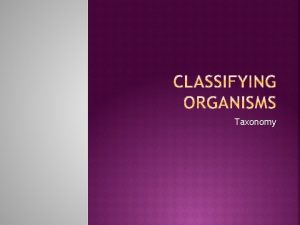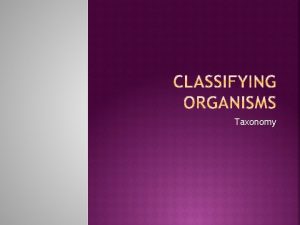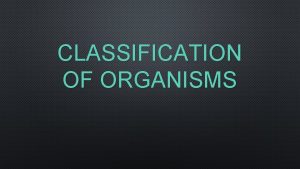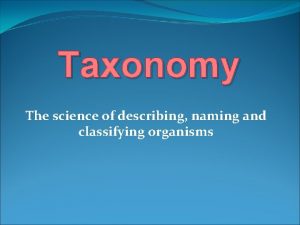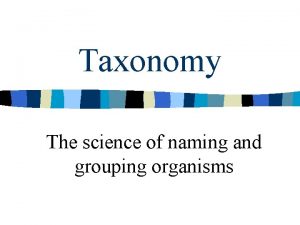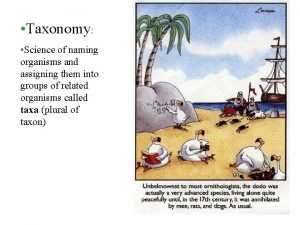TAXONOMY The Science of Naming and Classifying Organisms
























- Slides: 24

TAXONOMY The Science of Naming and Classifying Organisms

Which one of these is NOT actually a bear? Photo Credits Panda: Chi King Koala: Belgianchocolate Black Bear: Sparky. Leigh

Cougars, Mountain Lions, Pumas and Panthers are all the same cat (Puma concolor).

Consider this………. . • Are all “Grey Wolves” gray? • Are all “Black Bears” black? • Which is more venomous – a water moccasin or a cottonmouth?

CLASSIFICATION Carolus Linnaeus • Used Greek and Latin names • Created a system where we place all organisms into a few large groups called kingdoms • Those groups are further divided into smaller groups

Grouping • Kingdom • Phylum • Class • Order • Family • Genus • species Each group gets smaller and more specific – just think of the way you file things on your computer into folders and subfolders

To help you remember the list KING PHILIP CAME OVER FOR GREAT SOUP Kingdom, Phylum, Class, Order, Family, Genus, Species

To help you remember the list KINGS PLAY CHESS ON FINE GRAIN SAND Kingdom, Phylum, Class, Order, Family, Genus, Species


WHICH ARE MORE CLOSELY RELATED? Kingdom Animal Phylum Chordata Class Mammalia Order Carnivora Family Felidae Canidae Genus Panthera Canis species leo pardus lupus

WHICH ARE MORE CLOSELY RELATED? • Panthera leo & Canis leo • OR • Panthera leo & Panthera pardus

Humans Kingdom Phylum Class Order Family Genus Species Animalia Chordata Mammalia Primate Hominidae Homo sapiens The scientific name is always the genus + species Humans = Homo sapiens Photo by atomicshark

Lion Tiger Pintail Duck Kingdom Animalia Phylum Chordata Class Mammalia Aves Order Carnivora Anseriformes Family Felidae Anatidae Genus Panthera Anas Species leo tigris acouta What are the scientific names of each of these organisms?

BINOMIAL NOMENCLATURE • The system of naming • Means it is a 2 -name system.

More on Naming. . • Scientific names must either be underlined or italicized • The genus is always capitalized, the species is lowercase (Ex: Homo sapien) • Can be abbreviated. Ex. F. leo , F. tigris, H. sapien

What is a species? Defined as organisms that can interbreed with one another, and produce fertile offspring

HYBRID Example: ligers and mules

The Kingdoms • There are currently 6 kingdoms • Classification into a kingdom is based on certain criteria: o How it obtains energy o Number of cells o Type of cell o Movement

Kingdom Eubacteria & Kingdom Archaebacteria (Monera) • Heterotrophic or autotrophic • # of cells: Unicellular • No: Prokaryotes • Can move: Mobile • Ex: • Eubacteria = common bacteria • Archaebacteria = ancient bacteria, exists in extreme environments

Kingdom Protista/Protist • Heterotrophic or autotrophic • # of cells: unicellular or multicellular • Yes: Eukaryotic • Can move and not move: mobile or sessile • Flagella or cicllia • Examples: • Amoeba • Paramecium • Algae • Most live in Water Photo of Ameba by PROYECTO AGUA **/** WATER PROJECT

Kingdom Fungi • Heterotrophic • # of cells: Multicellular • Yes: Eukaryotic • Don’t move: Sessile • Have a cell wall Photos by nutmeg 66

Kingdom Plantae/Plants • Producer: Autotrophic • # of cells: Multicellular • Yes: Eukaryotic • Cannot move: Sessile (immobile) Photo by hira 3

Photo by Tambako the Jaguar Kingdom Animalia/Animals • Consumer: Heterotropic • # of cells: Multicellular • Yes: Eukakryotic • Can move: Mobile Photo by Eduardo Amorim

Three Domain System Domain Eukarya - includes organisms composed of eukaryotic cells (plants, animals, fungi, protists) Domain Bacteria - includes all prokaryotic cells, Kingdom Eubacteria Domain Archaea - includes only "ancient" bacteria, Archaebacteria
 Family order genus species
Family order genus species Canis latrans classification
Canis latrans classification Taxonomic classification
Taxonomic classification Fungi cell
Fungi cell Discipline of classifying and naming organisms
Discipline of classifying and naming organisms Discipline of classifying and naming organisms
Discipline of classifying and naming organisms Classification groups in order
Classification groups in order Most general to most specific classification
Most general to most specific classification Domain kingdom phylum mnemonic
Domain kingdom phylum mnemonic Kendall’s and marzano’s new taxonomy
Kendall’s and marzano’s new taxonomy Unicellular and multicellular organisms
Unicellular and multicellular organisms Classifying and exploring life lesson 1 answer key
Classifying and exploring life lesson 1 answer key Classifying organisms worksheet
Classifying organisms worksheet Lesson outline classifying organisms
Lesson outline classifying organisms Lesson 2 classifying organisms
Lesson 2 classifying organisms The scientific discipline of classifying organisms
The scientific discipline of classifying organisms Finding order in diversity
Finding order in diversity Dear king phillip came over
Dear king phillip came over Binomial nomenclature consists of two names *
Binomial nomenclature consists of two names * Organisms taxonomy
Organisms taxonomy Organisms taxonomy
Organisms taxonomy Member of the same species
Member of the same species My favourite subject is music
My favourite subject is music Examples of scientific skills
Examples of scientific skills Classifying science process skills
Classifying science process skills





